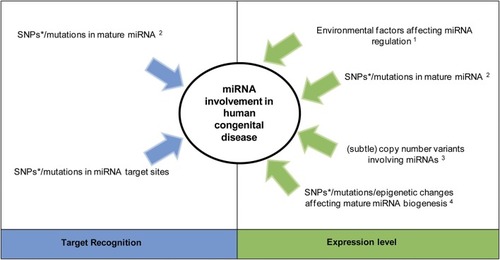
MiRNA involvement in congenital disease. Alterations affecting miRNA activity by changing target recognition or modulating their expression. *Single nucleotide polymorphisms (SNPs) within miRNAs are likely involved in complex disease (common disease, common variant hypothesis). 1Environmental factors can directly or indirectly regulate miRNA expression independent of any germline miRNA alteration (Zhao et al., 2008). 2A SNP/mutation within the miRNA seed sequence can alter both its processing and target recognition, while a change outside the seed sequence only alters miRNA processing (Duan et al., 2007). 3 Large copy number variants lead to syndromes while subtle ones (those only detectable via molecular methods) are predicted to be involved in complex diseases (Shelling and Ferguson, 2007). 4Germline alterations of regulators belonging to one of the two miRNA biogenesis/ processing pathways (i.e., the pathways involving mature miRNA generation from pri-miRNAs or Mirtrons, see Figure 2) will only change the expression level of mature miRNAs being generated through this pathway (Finnegan and Pasquinelli, 2013). Epigenetic changes in this context refer to functional changes without a change in the DNA sequence, such as methylation and histone modification.
|